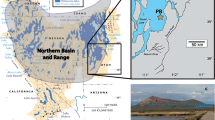Abstract
Two groups of poorly sorted ash-rich beds, previously interpreted as rain-flushed ashes, occur in the ca. AD 180 Hatepe Plinian pumice fall deposit at Taupo volcano, New Zealand. Two ash beds with similar dispersal patterns and an aggregate thickness of up to 13 cm make up the lowermost group (A). Group A beds extend 45 km north-east of the vent and cover 290 km2. In the southern part of the group A distribution area, a coarse ash to lapilli-size Plinian pumice bed (deposit B) separates the two group A beds. The scarcity of lapilli (material seen elsewhere from the still-depositing pumice fall) in group A beds indicates that they were rapidly transported and deposited. However, this rapid transportation and deposition did not produce cross-bedding, nor did it erode the underlying deposits. It is proposed that thick (>600 m) but dilute gravity currents generated from the collapsing outer margin of the otherwise buoyant Hatepe Plinian eruption column deposited the group A beds. The upper ash beds (group C) consist of one to seven layers, attain an aggregate thickness of ≤35 cm, and vary considerably in thickness and number of beds with respect to distance from vent. Group C beds contain variable amounts of ash mixed with angular Plinian pumices and are genuine rain-flushed ashes. Several recent eruptions at other volcanoes (Ukinrek Maars, Vulcan, Rabaul, La Soufrère de Guadeloupe and Soufrière, St Vincent) have produced gravity currents similar in style, but much smaller than those envisaged for group A deposits. The overloaded margins of otherwise buoyant eruption plumes generated these gravity currents. Laboratory studies have produced experimental gravity current analogues. Hazards from dilute gravity currents are considerable but often overlooked, thus the recognition of gravity current deposits will contribute to more thorough volcanic hazard assessment of prehistoric eruption sequences.
Similar content being viewed by others
References
Brazier S, Davis AN, Sigurdsson H, Sparks RSJ (1982) Fall-out and deposition of volcanic ash during the 1979 explosive eruption of the Soufrière of St. Vincent. J Volcanol Geotherm Res 14:335–359
Brazier S, Sparks RSJ, Carey SN, Sigurdsson H, Westgate JA (1983) Bimodal grain size distribution and secondary thickening in air-fall ash layers. Nature 301:115–119
Carey SN, Sigurdsson H (1987) Temporal variations in column height and magma discharge rate during the 79 A.D. eruption of Vesuvius. Geol Soc Am Bull 99:303–314
Carey SN, Sigurdsson H, Sparks RSJ (1988) Experimental studies of particle laden plumes. J Geophys Res 93:15314–15328
Fisher RV, Waters AC (1970) Base surge bedforms in maar volcanoes. Am J Sci 268:157–180
Folk RL, Ward WC (1957) Brazos River bar, a study in the significance of grain-size parameters. J Sedim Petrol 27:3–27
Heiken G, Crowe B, McGetchin T, West F, Eichelberger J, Bartram D, Peterson R, Wohletz K (1980) Phreatic eruption clouds: the activity of La Soufrière de Guadeloupe, F.W.I., August–October, 1976. Bull Volcanol 43:383–395
Houghton BF, Wilson CJN (1989) A vesicularity index for pyroclastic deposits. Bull Volcanol 51:451–462
Kienle J, Kyle PR, Self S, Motyka RJ, Lorenz V (1980) Ukinrek Maars, Alaska, I. April 1977 eruption sequence, petrology and tectonic setting. J Volcanol Geotherm Res 7:11–37
Lorenz V (1970) Some aspects of the eruption mechanism of the Big Hole maar, central Oregon. Geol Soc Am Bull 81:1823–1830
Lorenz V (1974) Vesiculated tuffs and associated features. Sedimentology 21:273–291
McKee CO, Johnson RW, Lowenstein PL, Riley SJ, Blong RJ, de Saint Ours P, Talai B (1985) Rabaul caldera, Papua New Guinea: volcanic hazards, surveillance, and eruption contigency planning. J Volcanol Geotherm Res 23:195–237
Patterson RT, Fishbein E (1989) Re-examination of the statistical methods used to determine the number of point counts needed for micropaleontological quantitative research. J Paleontol 63:245–248
Self S, Kienle J, Huot JP (1980) Ukinrek Maars, Alaska, II. Deposits and formation of the 1977 craters. J Volcanol Geotherm Res 7:39–65
Shepherd JB, Sigurdsson H (1982) Mechanism of the 1979 explosive eruption of Soufrière volcano, St. Vincent. J Volcanol Geotherm Res 13:119–130
Shepherd JB, Aspinall WP, Rowley KC, Pereira J, Sigurdsson H, Fiske RS, Tomblin JF (1979) The eruption of Soufrière volcano, St. Vincent, April–June 1979. Nature 282:24–28
Sheridan MF, Marshall JR (1983) Scanning electron microscopic examination of pyroclastic materials: basic considerations. Scanning Electron Microse 1983:113–118
Sheridan NW, Barberi F, Rosi M, Santacroce R (1981) A model for Plinian eruptions of Vesuvius. Nature 289:282–285
Sigurdssomn H (1982) Tephra from the 1979 Soufrière explosive eruption. Science 216:1106–1108
Sorem RK (1982) Volcanic ash clusters: tephra rafts and scavengers. J Volcanol Geotherm Res 13:63–71
Valentine GA (1987) Stratified flow in pyroclastic surges. Bull Volcanol 49:616–630
Walker GPL (1971) Grain-size characteristics of pyroclastic deposits. J Geol 79:696–714
Walker GPL (1981a) Plinian eruptions and their products. Bull Volcanol 44:223–240
Walker GPL (1981b) Characteristics of two phreatomagmatic ashes and their water-flushed origins. J Volcanol Geotherm Res 9:395–407
Walker GPL (1981c) The Waimihia and Hatepe Plinian deposits from the rhyolitic Taupo Volcanic Centre. N Z J Geol Geophys 24:305–324
Walker GPL (1981d) New Nealand case histories of pyroclastic studies. In: Self S, Sparks RSJ (eds) Tephra Studies. Reidel, Dordrecht
Wilson CJN, Walker GPL (1985) The Taupo eruption, New Zealand. I. General aspects. Phil Trans Roy Soc London A 314:199–228
Wohletz KH, Krinsley DH (1982) Scanning electron microscopic analysis of basaltic hydromagmatic ash. in: Whaley B, Krinsley D (eds) Scanning Electron Microscopy in Geology. Geo Abstracts, Norwich
Author information
Authors and Affiliations
Rights and permissions
About this article
Cite this article
Talbot, J.P., Self, S. & Wilson, C.J.N. Dilute gravity current and rain-flushed ash deposits in the 1.8 ka Hatepe Plinian deposit, Taupo, New Zealand. Bull Volcanol 56, 538–551 (1994). https://doi.org/10.1007/BF00302834
Received:
Accepted:
Issue Date:
DOI: https://doi.org/10.1007/BF00302834




